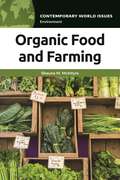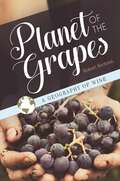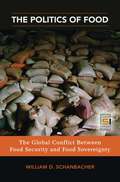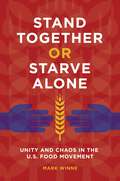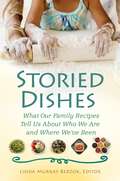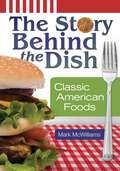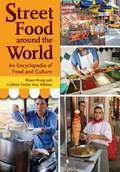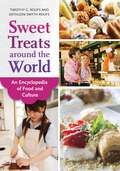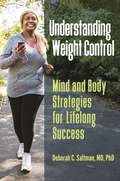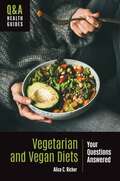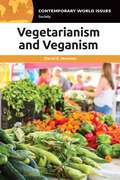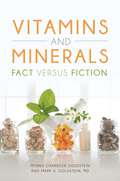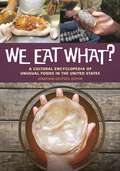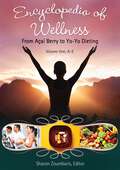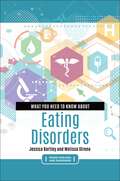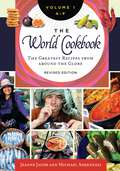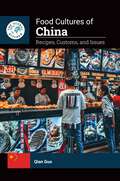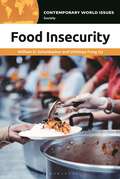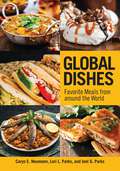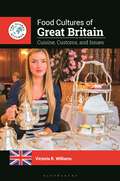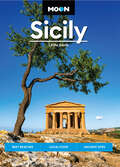- Table View
- List View
Obesity: A Reference Handbook (Contemporary World Issues)
by Judith S. Stern Alexandra KazaksObesity has reached epidemic proportions in countries like the United States. This book provides a comprehensive summary of obesity in America and around the world, discussing the causes and proposing ways to help stem the tide and to help those who are overweight.A highly useful and accessible resource for high school to undergraduate students as well as post-graduate level readers with an interest in health and nutrition, this updated second edition of Obesity: A Reference Handbook offers up-to-date answers to essential questions about obesity and connected societal and health care-related issues. A single-volume, go-to resource, this book addresses difficult questions such as whether obesity is a disease or a moral failing; what factors contribute to obesity; what the economic impacts of obesity are on the health care industry; if and how poverty is a contributor to obesity; how our society encourages obesity; and how changes can be made to improve our society's eating habits as a whole. It presents citations from individuals and peer-reviewed journals and review articles, providing a balance of information sourced from both professionals and informed lay commentators. Also included are dozens of biographies of individuals who have been important in studying, preventing, managing, or increasing awareness about obesity, such as Jared Fogle, longtime Subway sandwiches spokesperson; Kelly Brownell, who coined the phrase "toxic environment" to describe unhealthy food and exercise patterns; researcher Ethan Allen Sims, who examined the relationship between obesity and diabetes; and Oprah Winfrey, well-known celebrity who stated that if there were a pill to lose weight or a magic diet, she would have it.
Obesity: Your Questions Answered (Q&A Health Guides)
by Christine L. SelbyThis book serves as an accessible resource for teens who want to learn more about obesity. The information and guidance it offers make it a valuable tool for young adult readers with questions or concerns about their weight.Obesity—represented by a BMI over 30—may be easy to define, but its causes and consequences and how individuals and agencies should address it are not as clear. Is obesity simply the result of eating more calories than one burns, or are other factors involved? Can an individual be obese and healthy? How does obesity affect psychological and social health? Are public health campaigns targeted at reducing obesity helping or hurting? Obesity: Your Questions Answered, a part of Greenwood's Q&A Health Guides series, answers these and other questions related to this high-interest topic. Each book in this series follows a reader-friendly question-and-answer format that anticipates readers' needs and concerns. Prevalent myths and misconceptions are identified and dispelled, and a collection of case studies illustrates key concepts and issues through relatable stories and insightful recommendations. The book also includes a section on health literacy, equipping teens and young adults with practical tools and strategies for finding, evaluating, and using credible sources of health information both on and off the internet—important skills that contribute to a lifetime of healthy decision-making.
Organic Food and Farming: A Reference Handbook (Contemporary World Issues)
by Shauna M. McIntyreOrganic Food and Farming: A Reference Handbook is a valuable resource for students and general readers curious about the history, evolution, and growth of the organic food movement.Organic Food and Farming: A Reference Handbook begins with a deep dive into the origins of organic farming, offering a clear discussion of what constitutes organic production and how that has changed over time. Next, the volume provides a comprehensive overview of growth of organics as both an industry and a social movement and the inherent challenges that occur from trying to be both. The book additionally covers controversial issues and challenges, along with good news about what is working and what is possible. Included are essays by scholars, farmers, and experts working with NGOs as well as profiles of key people and organizations in the organic sector. Additional chapters include data and documents, a comprehensive resource list, and a detailed chronology of the key events in the history of the organic sector. Distinguishing it from others that laud or dismiss organic food and farming practices is this book's objective nature, which allows it to be used as a definitive resource on the topic.
Planet of the Grapes: A Geography of Wine
by Robert SechristA fascinating and comprehensive introduction to the geography, culture, and history of wine that identifies the significance of this simple beverage throughout human history and today.Wine was one the key founding foods of Western culture (bread and oil being the other two). It has played a key role in human history for thousands of years, having been used for enjoyment, rituals, and religious purposes; today, the production and consumption of wine is a billion-dollar industry that plays an important role in the global economy. Planet of the Grapes: A Geography of Wine provides an interesting and accessible lens through which students can learn about geography, culture, society, history, religion, and the environment. The chapters cover the historical geography of wine, document how drinking wine has often been condemned as a vice, and describe wines by region and type, thereby providing a cultural geography of wine.Readers will learn about the historical geography of wine, terroir (the environmental conditions that affect grape crops), grape biogeography, the process of winemaking from a geographic perspective, the economic global significance of the wine trade, the ongoing love-hate relationship between wine and government, and what makes individual wine regions distinct. The content is written to be comprehensible to individuals without detailed previous knowledge about wine but provides detailed information and insight that wine connoisseurs will find engaging. Additionally, through the story of wine comes a unique telling of the social transformations in America that have resulted from sources such as anti-immigrant sentiment, pseudoscience, and censorship.
The Politics of Food: The Global Conflict between Food Security and Food Sovereignty (Praeger Security International)
by William D. SchanbacherA description of the current global food system, this book challenges our ethical responsibility to the global poor and implicates us all for failing to curb global hunger and malnutrition.The Politics of Food: The Global Conflict between Food Security and Food Sovereignty argues that our current global food system constitutes a massive violation of human rights.In this impassioned, well-researched book, William Schanbacher makes the case that the food security model for combating global hunger—driven by the United Nations, the World Bank, the International Monetary Fund, and other organizations—is a failure, too dependent on trade and too reliant on international agribusiness. Instead, the emerging model of food sovereignty—helping local farmers and businesses produce better quality food—is the more effective and responsible approach. Through numerous case studies, the book examines critical issues of global trade and corporate monopolization of the food industry, while examining the emerging social justice movements that seek to make food sovereignty the model for battling hunger.
Stand Together or Starve Alone: Unity and Chaos in the U.S. Food Movement
by Mark WinneAmerica has a perplexing, multifaceted problem that combines hunger, obesity, and unhealthy food. This book examines how this situation was created and shows how people working together can resolve this longstanding issue.The United States—one of the world's wealthiest and resource-richest nations—has multiple food-related problems: declining food quality due to industrialization of its production, obesity across all age groups, and a surprisingly large number of households suffering from food insecurity. These issues threaten to shorten the lives of many and significantly reduce the quality of life for millions of others. This book explores the root causes of food-related problems in the 20th and 21st centuries and explains why collective impact—the social form of working together for a common goal—is the method that needs to be employed to reach a successful resolution to hunger, obesity, and the challenges of the industrial food system. Authored by Mark Winne, a 45-year food activist, the book begins with background information about the evolution of the U.S. food movement since the 1960s that documents its incredible growth and variety of interests, organizations, and sectors. The subsequent sections demonstrate how these divergent interests have created a lack of unity and constitute a deterrent to achieving real change and improvement. Through examples from specific cities and states as well as a discussion of group dynamics and coalition-building methods, readers will come away with an understanding of a complicated topic and grasp the potential of a number of strategies for creating more cohesion within the food movement—and realizing meaningful improvements in our food system for current and future generations.
Starbucks (Corporations That Changed the World)
by Marie A. BussingSince its humble beginnings at Seattle's Pike Place Market in 1971, Starbucks has grown to become an industry leader and household name. This book takes an in-depth look at the evolution of this dynamic and sometimes controversial corporation.Americans drink 400 million cups of coffee every day, and many of them come from the thousands of Starbucks coffeehouses across the country. But how much do you really know about the place you get your morning cup of Joe?Part of Greenwood&’s Corporations That Changed the World series, this book provides readers with a richly detailed history of this famous coffeehouse chain. It traces StarbuckS&Rsquo; meteoric rise from a small Seattle-based company to an international powerhouse, chronicling how the changing executive leadership affected corporate strategy and direction. It also explores how Starbucks has embraced and incorporated new technologies and innovations, as well as how the corporation has shaped and been shaped by important social causes. An unbiased look at the controversies that have surrounded Starbucks over the years will help readers better understand these contentious issues. This updated and expanded edition includes new chapters, current financial data, and coverage of the COVID-19 pandemic's impact on the company.
Storied Dishes: What Our Family Recipes Tell Us About Who We Are and Where We've Been
by Linda Murray BerzokWe are what we eat—not just physiologically, but culturally. This collection of cross-cultural, generational essays, and accompanying recipes shows the profound importance of food dishes within American women's lives.For people of every ethnicity, food provides much more than mere fuel for the body—it contains an invisible component that ties families and generations together with the continuity of shared experience. And for the women who are entrusted with the responsibility of keeping that priceless cultural thread intact, family recipes embody tradition, bridge generation gaps, and erase age differences.This book is organized around 50 short essays and recipes presented by women from multicultural backgrounds and dissimilar walks of life. The chapters depict the paths of these individuals in their lives and the details of how they acquired their precious family recipes. The stories document how women universally use inherited family recipes to remember and memorialize key women in their lives and to aid and measure their own growth and development. Included are reminiscences of an Egyptian aunt, a poor mother from Australia, a Katrina-flooded New Orleans family, Turkish relations, Chinese mothers, and Indian grandmothers.
The Story Behind the Dish: Classic American Foods
by Mark McWilliamsProfiling 48 classic American foods ranging from junk and fast food to main dishes to desserts, this book reveals what made these dishes iconic in American pop culture.Americans have increasingly embraced food culture, a fact proven by the rising popularity of celebrity chefs and the prominence of television shows celebrating food themes. This fascinating overview reveals the surprising story behind the foods America loves.The Story Behind the Dish: Classic American Foods is an engaging pop culture resource which helps tell the story of American food. Each chapter is devoted to one of 48 distinctive American dishes and features the story of where the food developed, what inspired its creation, and how it has evolved. The book not only covers each food as a single entry, but also analyzes the themes and events that connect them, making the text useful as both a reference and a narrative on the history of food.
Street Food around the World: An Encyclopedia of Food and Culture
by Bruce Kraig Colleen Taylor Sen Fuad Ahmad Chitradeepa Anatharam Paula Arvela Rosemary Barron Manya Brachear Cynthia Clampitt Charlotte De Backer Monica Eng Clothilde Façon Rachel Finn Ove Fosså Olívia Fraga Shahrzad Ghorashian David Hammond Anissa Helou Richard Hosking Sharon Hudgins Phil Iddison Katrine Klinken Robert Launay Whitney Lingle Máirtín Mac Con Iomaire Ian Martin Laura Mason Marcela Mazzei Adrian Miller Katerina Nussdorfer Sarahlynn Pablo Gaitri Pagrach-Chandra Jorge Pérez Birgit Ricquier Nanna Rögnvaldardóttir Helen Saberi Heba Saleh María José Sevilla Mike Sula Richard Tan Aylin Öney Tan Viktorija Todorovska Karin Vaneker Paul Van Reyk Susan WeingartenIn this encyclopedia, two experienced world travelers and numerous contributors provide a fascinating worldwide survey of street foods and recipes to document the importance of casual cuisine to every culture, covering everything from dumplings to hot dogs and kebabs to tacos.Street foods run deep throughout human history and show the movements of peoples and their foods across the globe. For example, mandoo, manti, momo, and baozi: all of these types of dumplings originated in Central Asia and spread across the Old World beginning in the 12th century. This encyclopedia surveys common street foods in about 100 countries and regions of the world, clearly depicting how "fast foods of the common people" fit into a country or a region's environments, cultural history, and economy. The entries provide engaging information about specific foods as well as coverage of vendor and food stall culture and issues. An appendix of recipes allows for hands-on learning and provides opportunities for readers to taste international street foods at home.
Sweet Treats around the World: An Encyclopedia of Food and Culture
by Timothy G. Roufs Kathleen Smyth RoufsFrom apple pie to baklava, cannoli to gulab jamun, sweet treats have universal appeal in countries around the world. This encyclopedia provides a comprehensive look at global dessert culture.Few things represent a culture as well as food. Because sweets are universal foods, they are the perfect basis for a comparative study of the intersection of history, geography, social class, religion, politics, and other key aspects of life. With that in mind, this encyclopedia surveys nearly 100 countries, examining their characteristic sweet treats from an anthropological perspective. It offers historical context on what sweets are popular where and why and emphasizes the cross-cultural insights those sweets present. The reference opens with an overview of general trends in desserts and sweet treats. Entries organized by country and region describe cultural attributes of local desserts, how and when sweets are enjoyed, and any ingredients that are iconic. Several popular desserts are discussed within each entry including information on their history, their importance, and regional/cultural variations on preparation. An appendix of recipes provides instructions on how to make many of the dishes, whether for school projects or general entertaining.
Understanding Weight Control: Mind and Body Strategies for Lifelong Success
by Deborah C. PH.DThis guide explains why we gain weight and what we can do to lose it. Without advocating any particular diet, it details a mind-body strategy for realistic lifetime weight management.Aiming to instill healthy perspectives for lifelong weight control, this book focuses on strategies that are designed to be modified and rotated throughout life to promote motivation, liveliness, and curiosity—key elements of not only losing weight but maintaining a healthy one. Each chapter is backed by the latest scientific evidence, presented in a way that is clear and understandable to readers. Emerging successful strategies are highlighted, and myths such as those developed by product and diet advertising campaigns are debunked. Understanding Weight Control: Mind and Body Strategies for Lifelong Success presents a general, science-backed plan for long-term weight management. The author explains the physical and psychological factors of weight control—why our fat cells sometimes go rogue and what habits and other factors we can control to change that. She addresses coping with the mental challenges that accompany weight loss and control and additionally shares illustrative stories from her weight loss patients as well as from her own experience.
Vegetarian and Vegan Diets: Your Questions Answered (Q&A Health Guides)
by Alice C. RicherWhile following a plant-based diet can provide many health and environmental benefits, vegetarians and vegans are at greater risk for certain nutritional deficiencies. They may also face challenges when grocery shopping, dining out, and interacting with friends and family.More and more Americans are reducing or completely eliminating meat and other animal products from their diet. Some are motivated by concerns surrounding animal welfare and the environmental impact of meat, while others hope to improve their health by following a plant-based diet. Although a vegetarian or vegan diet can provide many benefits, it can also pose unique challenges and health risks.Part of Greenwood's Q&A Health Guides series, Vegetarian and Vegan Diets: Your Questions Answered follows a reader-friendly question-and-answer format that anticipates readers' needs and concerns. Prevalent myths and misconceptions are identified and dispelled, and a collection of case studies illustrates key concepts and issues through relatable stories and insightful recommendations. Each book in the series also includes a section on health literacy, equipping teens and young adults with practical tools and strategies for finding, evaluating, and using credible sources of health information both on and off the internet—important skills that contribute to a lifetime of healthy decision-making.
Vegetarianism and Veganism: A Reference Handbook (Contemporary World Issues)
by David E. NewtonThis detailed and comprehensive overview of meat-free diets introduces readers to their long history in human cultures and analyzes some of the important questions and issues surrounding their practice in today's world.Vegetarianism and Veganism: A Reference Handbook provides a history and background of vegetarianism and veganism from prehistorical times to the present day, along with detailed discussions of the practice in each historical period since that time. The ancillary chapters provide additional information on important individuals and organizations in the field, relevant data and documents on the topic, an annotated bibliography, a chronology of important events, and a glossary of terms likely to be encountered in the field. Of special interest is the Perspectives chapter, in which stakeholders in the topic write about some specific aspect of its importance in their own lives.Intended for high school, college, an general readers, the volume covers the field of vegetarianism and veganism in cultures from around the world. Some specific topics include ancient views of vegetarianism, religious stands on the practice, the growth of vegetarian and vegan institutions, and current controversies over the practice of meat-free diets. It also includes a host of resources that readers can use to continue their own research in the field.
Vitamins and Minerals: Fact versus Fiction
by Myrna Chandler Goldstein Mark A. MDThis accessible reference profiles the vitamins and minerals most important to human health, presenting information in an easy-to-use format and summarizing the findings of key research studies.Everyone knows that vitamins and minerals are nonnegotiable components of optimal health. But what exactly do these substances do in the body, and how much of each is needed? What happens if an individual ingests too little or too much of a particular vitamin or mineral? Which foods are the best sources of them, and are dietary supplements a safe alternative? Do certain vitamins and minerals offer protection against certain diseases and medical conditions?Vitamins and Minerals: Fact versus Fiction provides answers to these and many other questions in an accessible format, backed by summaries of key research findings. This book cuts through the confusion and hype that surround the nutrition and supplements industries to offer readers clear guidance founded on solid medical research. A standardized chapter structure and several appendices make the most important information readily available, while introductory essays explore fundamental topics—such as different types of intake recommendations and how they're determined—in greater depth.
We Eat What?: A Cultural Encyclopedia of Unusual Foods in the United States
by Jonathan Deutsch, Benjamin Fulton and Alexandra ZeitzThis entertaining and informative encyclopedia examines American regional foods, using cuisine as an engaging lens through which readers can deepen their study of American geography in addition to their understanding of America's collective cultures.Many of the foods we eat every day are unique to the regions of the United States in which we live. New Englanders enjoy coffee milk and whoopie pies, while Mid-Westerners indulge in deep dish pizza and Cincinnati chili. Some dishes popular in one region may even be unheard of in another region. This fascinating encyclopedia examines over 100 foods that are unique to the United States as well as dishes found only in specific American regions and individual states. Written by an established food scholar, We Eat What? A Cultural Encyclopedia of Bizarre and Strange Foods in the United States covers unusual regional foods and dishes such as hoppin' Johns, hush puppies, shoofly pie, and turducken. Readers will get the inside scoop on each food's origins and history, details on how each food is prepared and eaten, and insights into why and how each food is celebrated in American culture. In addition, readers can follow the recipes in the book's recipe appendix to test out some of the dishes for themselves. Appropriate for lay readers as well as high school students and undergraduates, this work is engagingly written and can be used to learn more about United States geography.
Encyclopedia of Wellness [3 volumes]: From Açaà Berry to Yo-Yo Dieting [3 volumes]
by Sharon ZoumbarisThis wide-ranging encyclopedia addresses our rapidly changing understanding of health and wellness, providing a collection of essays that are up-to-date and comprehensive in both scope and breadth.Encyclopedia of Wellness: From Açaí Berry to Yo-Yo Dieting offers expert advice to anyone seeking information on a condition or illness. More than that, however, this three-volume resource is a compendium of practical information on how to reduce poor health choices and live a healthy, active, vibrant life.A source of basic, easily understandable entries on health and wellness, the encyclopedia covers an extraordinarily broad array of health-related topics including acupuncture, art therapy, biofeedback, food additives, nutrition labels, organic foods, and workplace wellness. Bulimia is covered, as are depression, autism, cancer, and environmental hazards. Essays examine issues related to healthy living for the mind and the body, stressing the importance of the mind-body connection to good health. Information is also offered on practical concerns such as medical savings accounts, changes in medical insurance, and the U.S. health care system. Throughout, the encyclopedia presents knowledge gleaned from new research on treatment and especially on choices in nutrition and exercise.
What You Need to Know about Eating Disorders (Inside Diseases and Disorders)
by Jessica Bartley Melissa StrenoThis book provides readers with information to better understand eating disorders, written in accessible language for teens and young adults—those most at risk for these potentially deadly mental disorders.Eating disorders, including anorexia nervosa, bulimia nervosa, and binge eating disorder, are some of the most commonly diagnosed mental disorders. They are also the deadliest: in the United States, an individual dies as the result of an eating disorder every hour.What You Need to Know about Eating Disorders is a part of Greenwood's Inside Diseases and Disorders series. This series profiles a variety of physical and psychological conditions, distilling and consolidating vast collections of scientific knowledge into concise, readable volumes. A list of "top 10" essential questions begins each book, providing quick-access answers to readers' most pressing concerns. The text follows a standardized, easy-to-navigate structure, with each chapter exploring a particular facet of the topic. In addition to covering basics such as causes, signs and symptoms, diagnosis, and treatment options, books in this series delve into issues that are less commonly addressed but still critically important, such as effects on loved ones and caregivers. Case illustrations highlight key themes discussed in the book, accompanied by insightful analyses and recommendations.
The World Cookbook [4 volumes]: The Greatest Recipes from around the Globe [4 volumes]
by Jeanne Jacob Michael AshkenaziThis is the only world cookbook in print that explores the foods of every nation-state across the globe, providing information on special ingredients, cooking methods, and commonalities that link certain dishes across different geographical areas.Increasing globalization, modern communication, and economic development have impacted every aspect of daily life, including the manner by which food is produced and distributed. While these trends have increased the likelihood and expansion of food influences, variations of the same popular dishes have been found in regions all over the world long before now. This book is an ecological, historical, and cultural examination of why certain foods are eaten, and how these foods are prepared by different social groups within the same—and different—geographical region. The authors cover more than 200 countries and cultural groups, featuring each nation's food culture and traditions, and providing overviews on foodstuffs, typical dishes, and styles of eating. This revised edition features in excess of 400 new recipes, several new countries, and additional sidebars with fun facts explaining unique foods and unfamiliar ingredients. More than 1,600 recipes for popular appetizers, main courses, desserts, snack foods, and celebration dishes are provided, allowing readers to construct full menus from every country of the world.
Food Cultures of China: Recipes, Customs, and Issues (The Global Kitchen)
by Qian GuoExploring the rich and varied culinary traditions of China, this book enables a better understanding of Chinese history and culture through food.Part of Bloomsbury's Global Kitchen series, this book takes readers on a food tour of China, covering everything from daily staples to holiday specialties. In addition to discovering China's long culinary history, you'll learn about recent trends, foreign influences, and contemporary food and dietary concerns, such as obesity and environmental sustainability.Chapters are organized thematically, making it easy to focus in on particular courses or types of dishes. For those hungry for a more hands-on approach, each chapter includes a collection of accessible recipes that allow readers to bring the subject to life in their own kitchens. The main text is supplemented by sidebars that offer interesting bite-sized facts, a chronology of important dates in China's culinary history, and a glossary of key food- and dining-related terms. Sun Yat-sen, the founding father of modern China, asserted that China's food culture was the most advanced and sophisticated in the world, despite the country lagging the West in science, industry, and civic engagement. Today, many people outside China immediately envision iconic dishes like fried rice, egg rolls, or sweet and sour pork when they think of Chinese food. But China has a much richer and more diverse set of culinary traditions. China's food culture is one of the oldest in the world, evolving over thousands of years. It has been shaped by a myriad of forces, from historical struggles with food insecurity to the modern push toward speed and convenience. Across this large nation, unique cuisines emerged that reflect the varied geography, climate, and customs of different regions.
Food Insecurity: A Reference Handbook (Contemporary World Issues)
by William D. Schanbacher Whitney Fung UyThis comprehensive and authoritative one-stop resource examines the issue of food insecurity in the United States, including the various economic, social, political, and cultural factors that drive the problem.Social welfare agencies, schools, food banks, and other organizations have all put forth efforts to combat food insecurity, but it remains a serious risk for millions of poor Americans today. Food Insecurity: A Reference Handbook examines the reasons why food insecurity remains such a longstanding problem in American society.Beginning with a history of food insecurity from the country's origins to the present day, the book also delves into the problems and controversies related to food insecurity, such as urban food deserts, substance abuse impacts, nutrition education, and income inequality. One of the most valuable aspects of the book is that it surveys the history of food insecurity in a manner that helps the reader identify key issues in an easy-to-understand fashion. The book's Perspectives chapter presents a broad range of voices on various facets of food insecurity, providing crucial, diverse perspectives to round out the coverage and expertise of the authors.
Food Shortage Crisis: Origins and Global Impact
by Dawn M. DrakeDiscover the history, causes, impacts, and potential future of global food shortages-a problem for all of humanity, not just the developing world.This important reference work takes an in-depth look at the geographic nature of the problem of global food shortages, helping readers to understand that while this is not a problem that exists everywhere, it is a problem that touches everyone. The book begins with an introduction to the basics of global food shortages, moves through the history of the issue, and then explains the current state of affairs. From there, it examines root causes, proposes solutions, and takes a speculative look into the future. This organization moves readers through the problem in a systematic and easy-to-follow manner, while also allowing them to explore each aspect of the issue individually. A curated selection of further readings at the end of each chapter points readers toward resources for additional research and discovery. The book concludes with a selection of perspective essays written by expert contributors. Each explores a different facet of the topic, from the potential of GMO crops to the impact of food waste.Food Shortage Crisis illustrates that the problems of food scarcity and insecurity are neither new nor confined to the developing world. They are the result of a complex interplay of issues at every stage of the process of feeding humanity, from food production to sale and distribution to consumption. Age-old factors such as poverty and inequality are compounded by new realities such as climate change. Global food shortages affect more than human health; they have the potential to cause economic devastation, trigger civil unrest and international conflicts, and change how we as humans interact with the planet and each other.
Global Dishes: Favorite Meals from around the World
by Caryn E. Neumann Lori L. Parks Joel G. ParksThrough an interdisciplinary approach that shows how food can reflect a culture and time, this book whets the appetite of students for further research into history, anthropology, geography, sociology, and literature.Food is a great unifier. It is used to mark milestones or rites of passage. It is integral to the way we celebrate, connecting a familial and cultural past to the present through tradition. It bolsters the ill and soothes those in mourning. The dishes in this text are those that have come to be known within a part of the world and culture, but also have moved beyond those borders and are accessible and enjoyed by many in our ever-smaller and more-interconnected world.Featuring more than 100 recipes and detailed discussions of dishes from across the globe, Global Dishes: Favorite Meals from around the World explores the history and cultural context surrounding some of the best-known and favorite foods. The book covers national dishes from more than 100 countries, including large nations like Mexico and small countries like Macao. There is also coverage of foods beloved by Indigenous peoples, such as the Sami of Scandinavia. Traditional favorites are offered as well as newer dishes.
Food Cultures of Great Britain: Cuisine, Customs, and Issues (The Global Kitchen)
by Victoria R. WilliamsThere's far more to British food than fish and chips. Discover the history and culture of Great Britain through its rich culinary traditions.Part of the Global Kitchen series, this book takes readers on a food tour of Great Britain, covering everything from daily staples to holiday specialties. In addition to discovering Great Britain's long culinary history, you'll learn about recent trends, foreign influences, and contemporary food and dietary concerns, such as obesity and the impacts of climate change. Chapters are organized thematically, making it easy to focus in on particular courses or types of dishes. The main text is supplemented by sidebars that offer interesting bite-sized facts, a chronology of important dates in British culinary history, and a glossary of key food- and dining-related terms.When people outside Great Britain think of British cuisine, they likely envision iconic foods and traditions such as fish and chips, a full English breakfast, and afternoon tea. But Great Britain has a much richer and more diverse culinary history. It has been shaped by a myriad of events, from invasions by the Romans, Vikings, and Normans to the emergence and expansion of the British Empire to the privations of World War II. In more recent times, Great Britain's departure from the European Union, the global Covid-19 pandemic, and Russia's invasion of Ukraine have all had a significant impact on the food landscape of Great Britain.
Moon Sicily: Best Beaches, Local Food, Ancient Sites (Travel Guide)
by Linda Sarris Moon Travel GuidesFrom relaxing on sun-soaked beaches to hiking Mount Etna, immerse yourself in la dolce vita with Moon Sicily. Inside you'll find:Flexible itineraries for exploring the best of Sicily, including Palermo, Western Sicily, the Aeolian Islands, Catania, Mount Etna, Syracuse, and more Strategic advice for foodies and oenophiles, art lovers, hikers, history buffs, beach bums, and more Must-see highlights and unique experiences for any season: Go climbing and wine-tasting on scenic Mount Etna. Visit the noble palaces and flourishing outdoor markets of Palermo. Island-hop and soak up the spectacular beaches of the Aegadian Islands. Walk among Greek ruins at the Valle dei Templi and wander romantic towns like Cefalú and Taormina The best local flavors: Savor fresh seafood straight from the Mediterranean, sample locally made sheep cheese, and taste some of Italy&’s best street food in Palermo. Enjoy diverse Sicilian wines like historic marsala and sip a morning cappuccino at a charming café Expert advice from Palermo local and chef Linda Sarris on where to stay, what to eat, and how to get around Full-color photos and detailed maps throughoutBackground information on the landscape, history, and cultural customs Handy tools including an Italian phrasebook and tips for senior travelers, travelers of color, traveling with children, and more With Moon&’s practical tips and local insight on the best things to do and see, you can experience the very best of Sicily. Exploring more of Italy? Check out Moon Southern Italy or Moon Rome, Florence & Venice.About Moon Travel Guides: Moon was founded in 1973 to empower independent, active, and conscious travel. We prioritize local businesses, outdoor recreation, and traveling strategically and sustainably. Moon Travel Guides are written by local, expert authors with great stories to tell—and they can't wait to share their favorite places with you. For more inspiration, follow @moonguides on social media.


